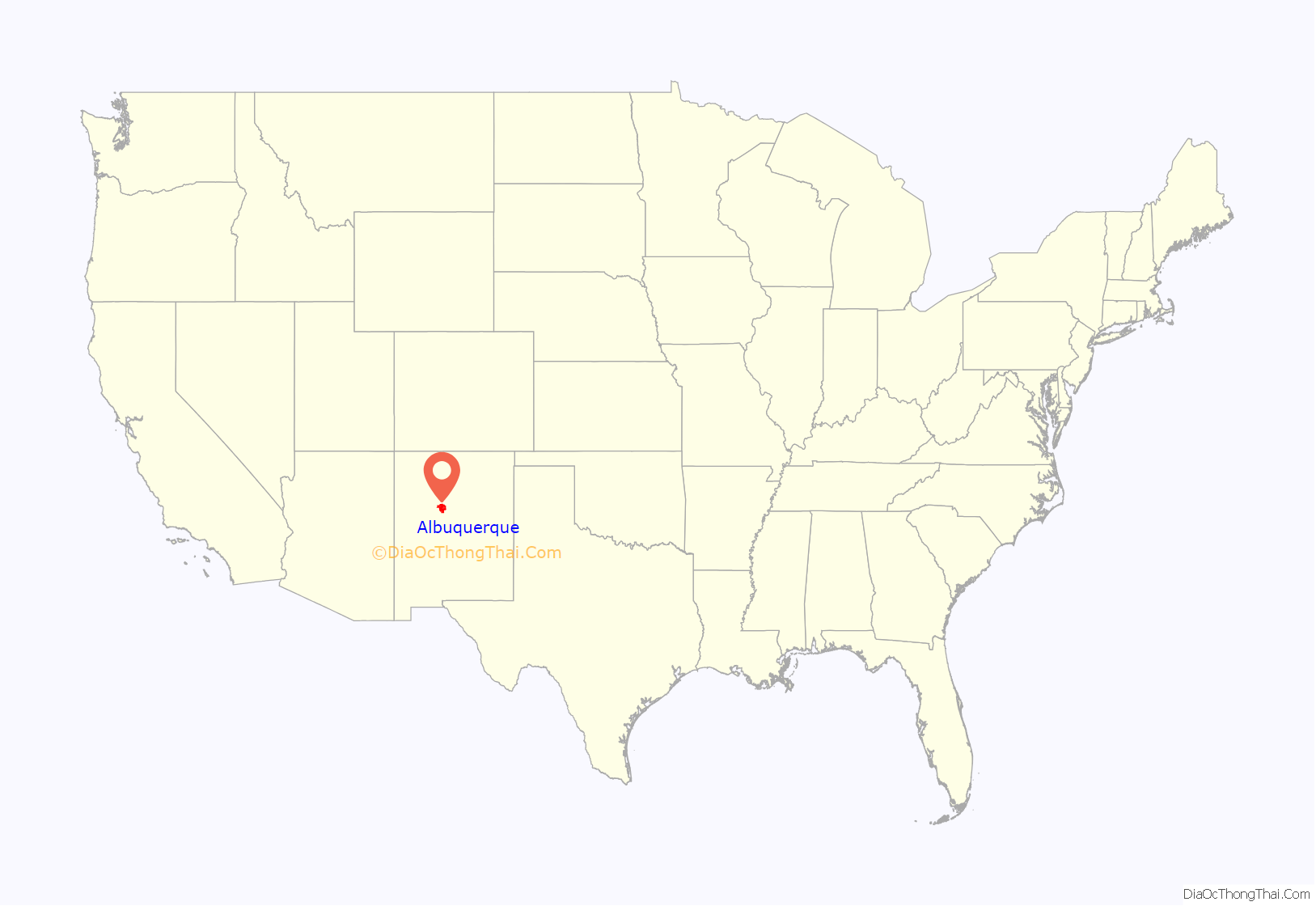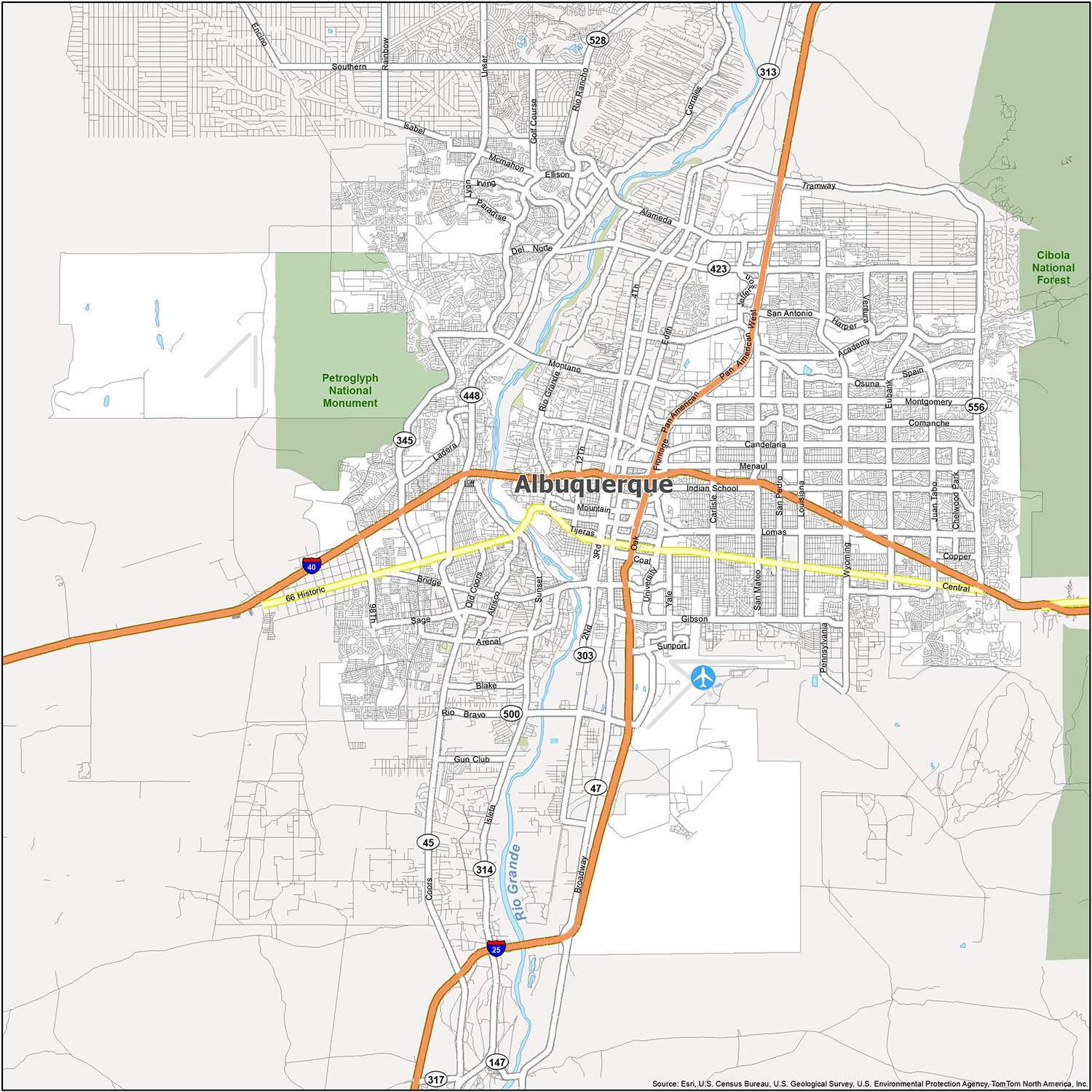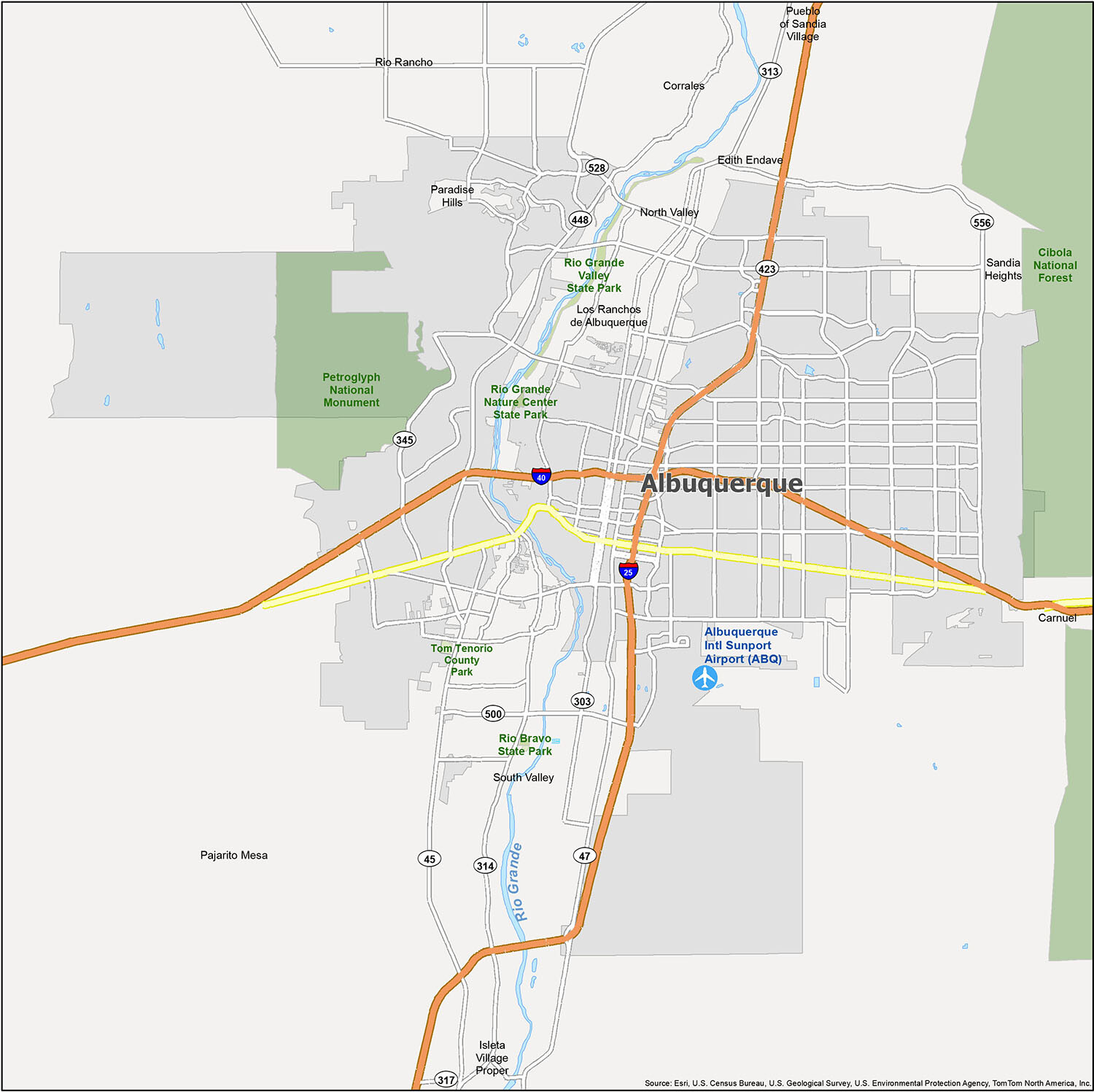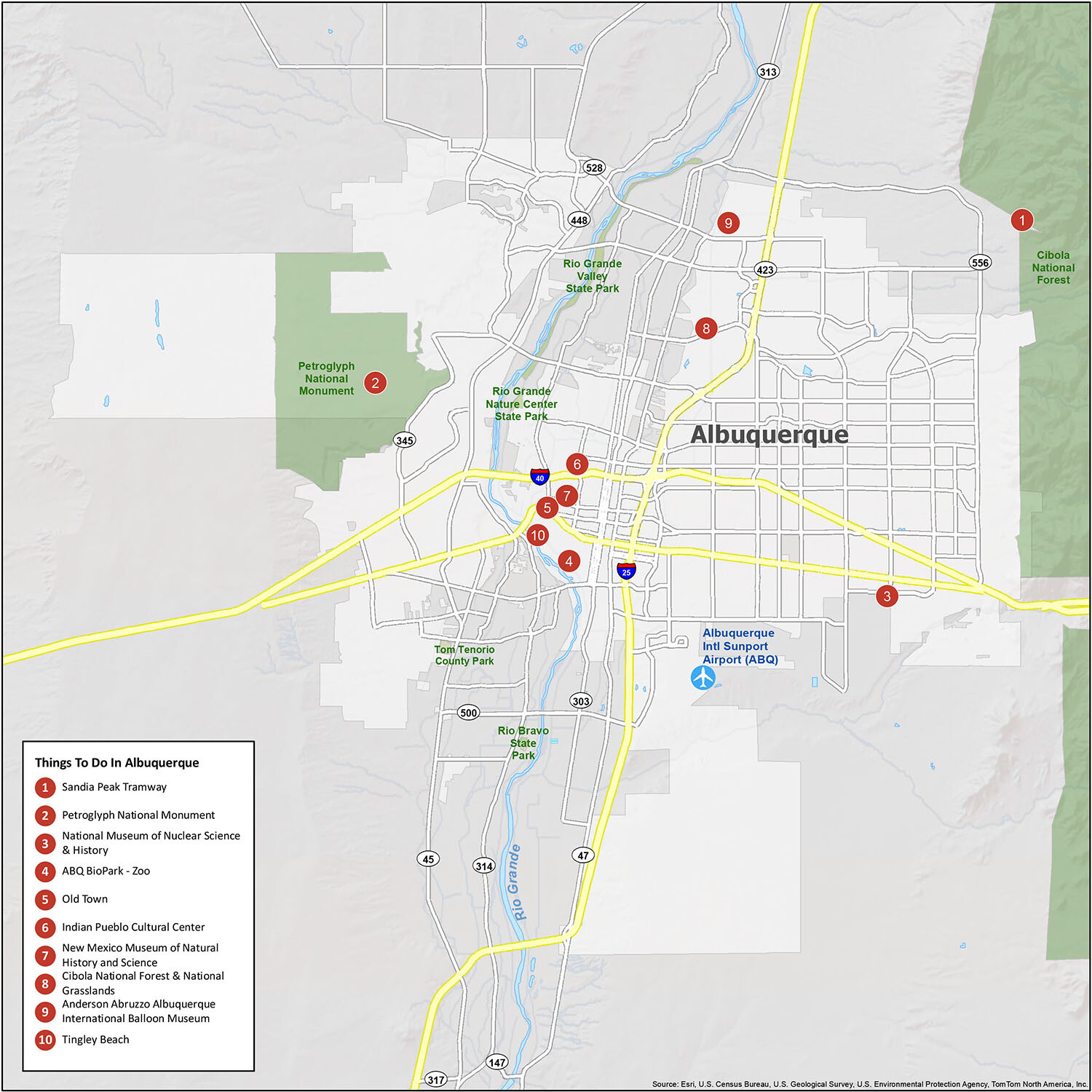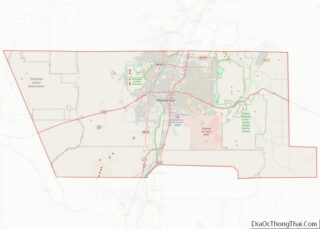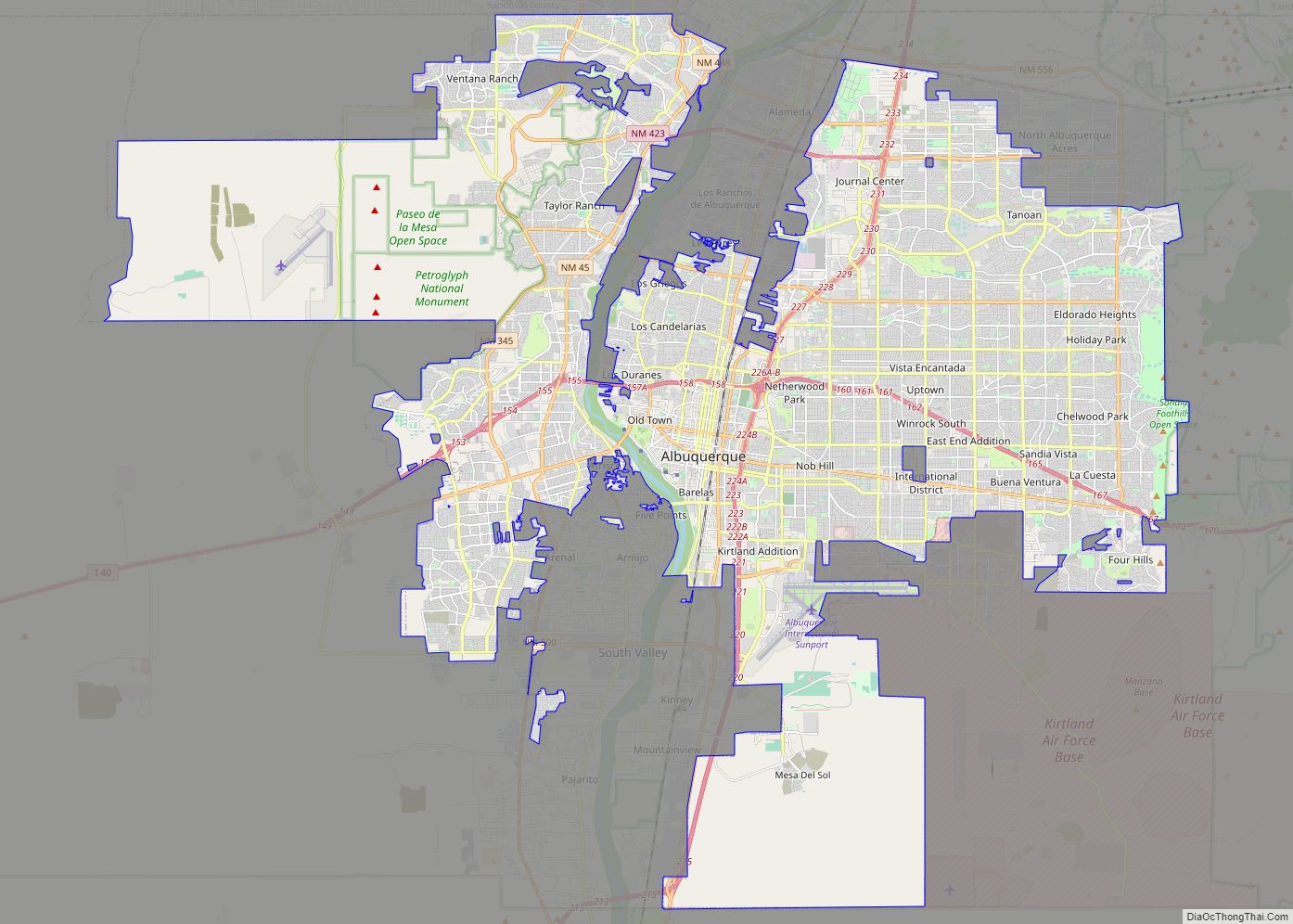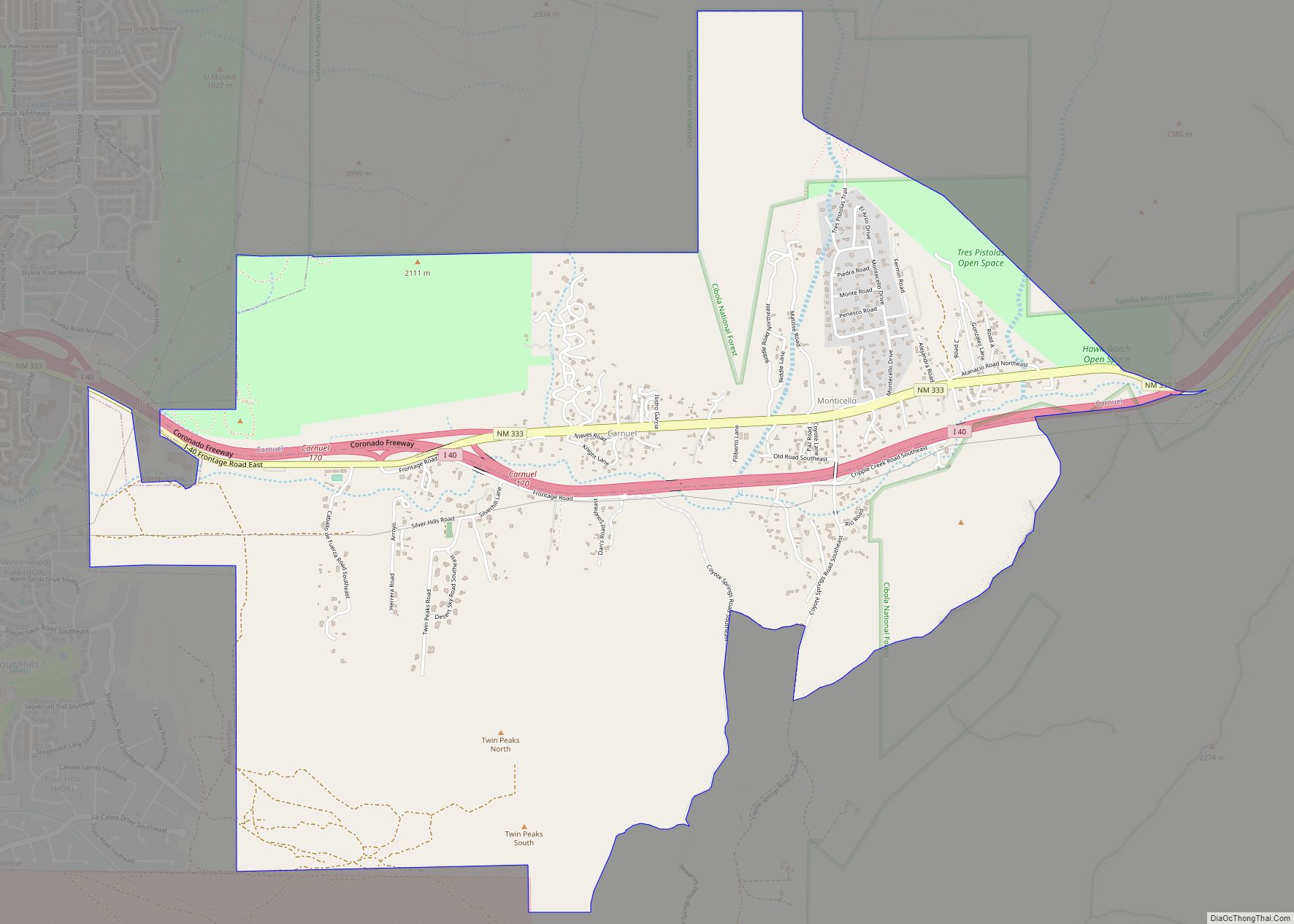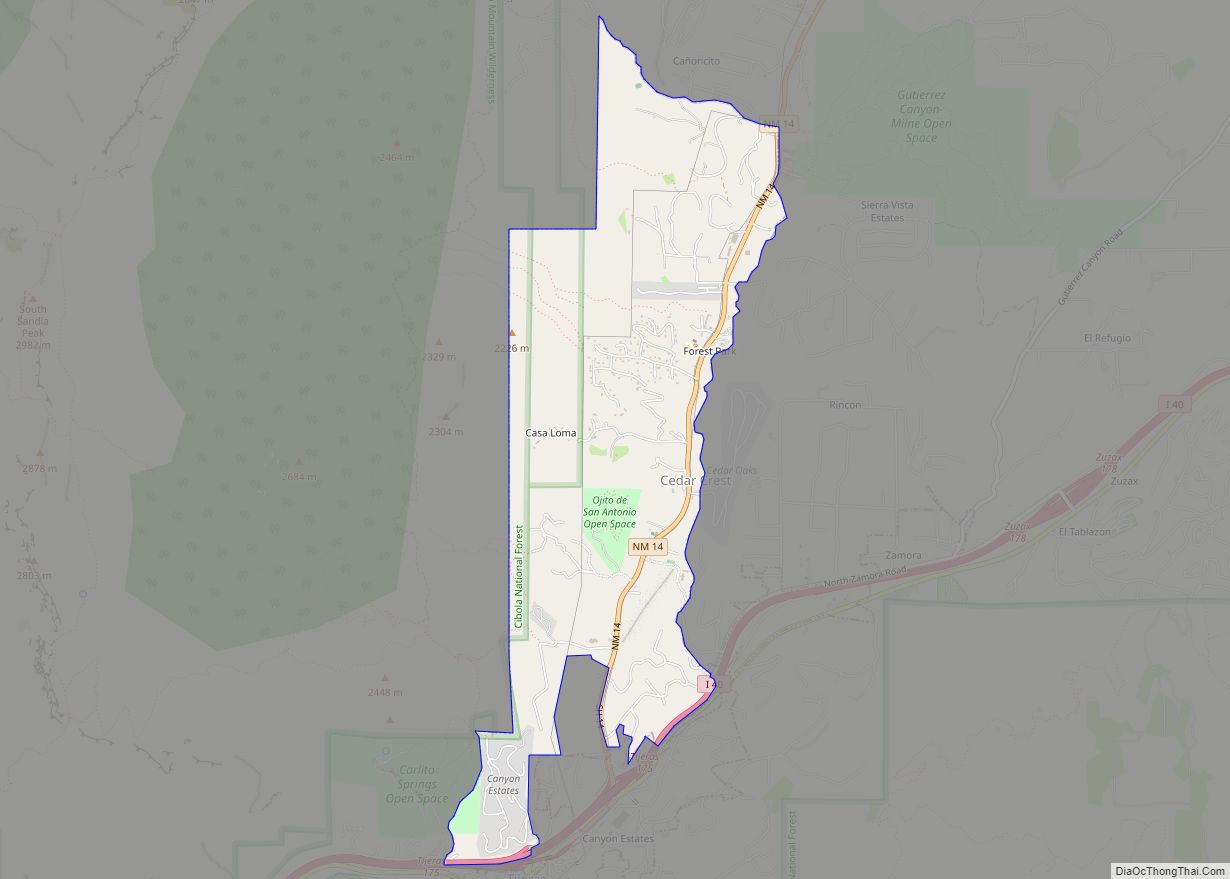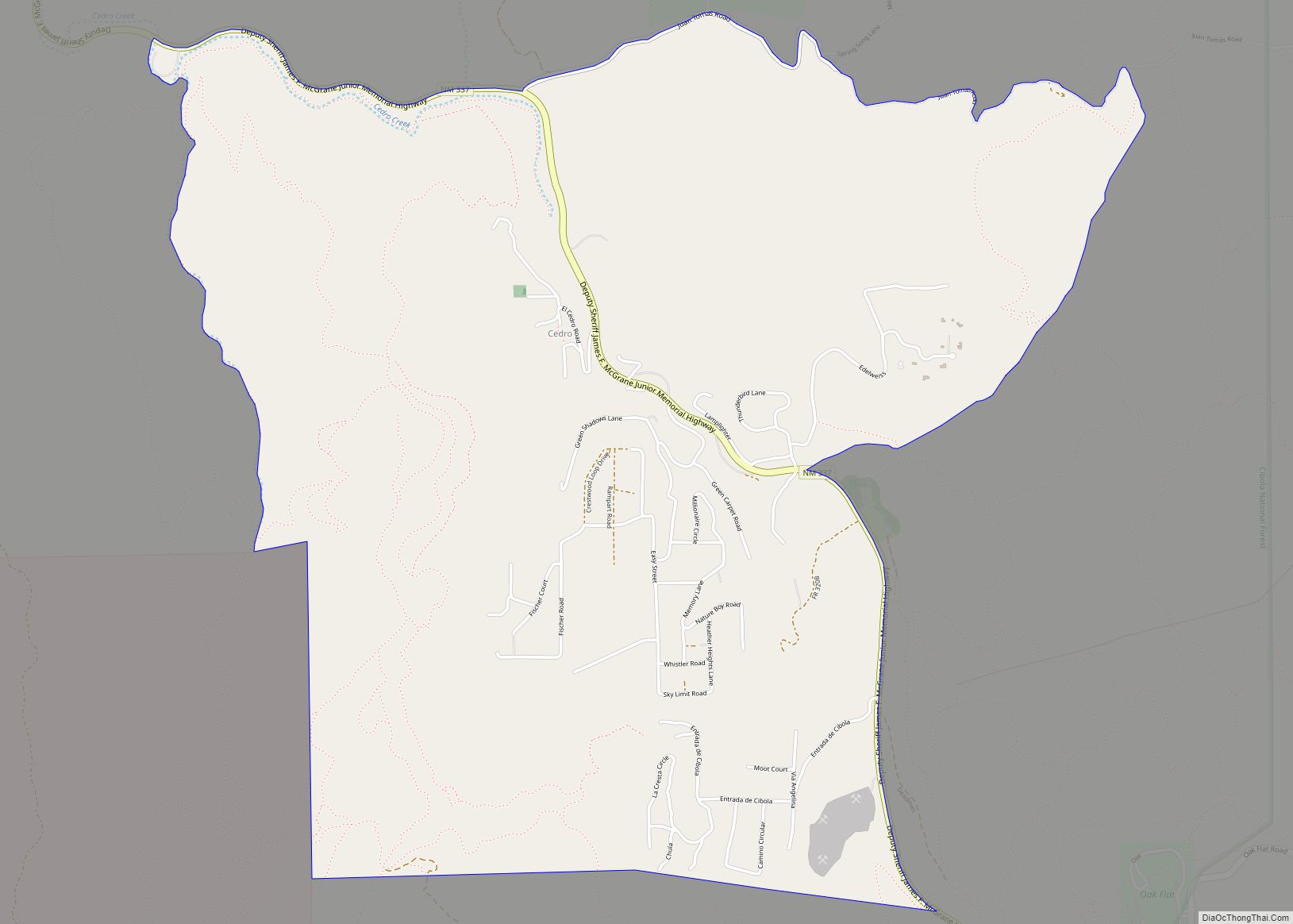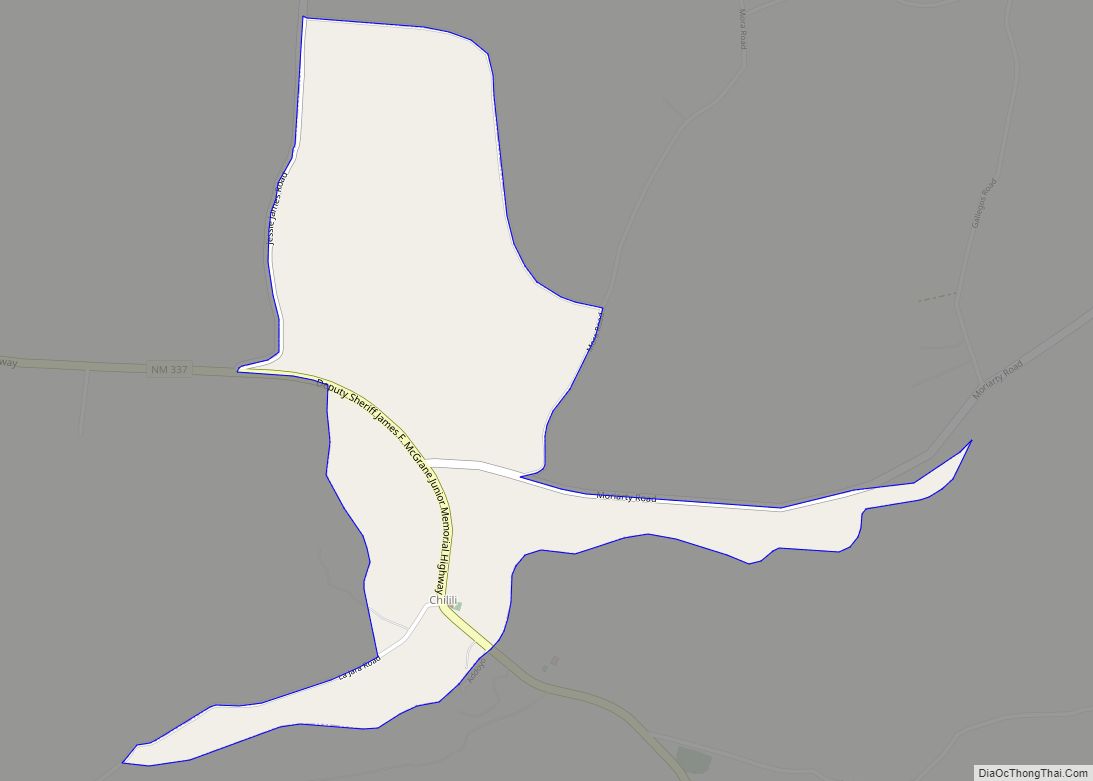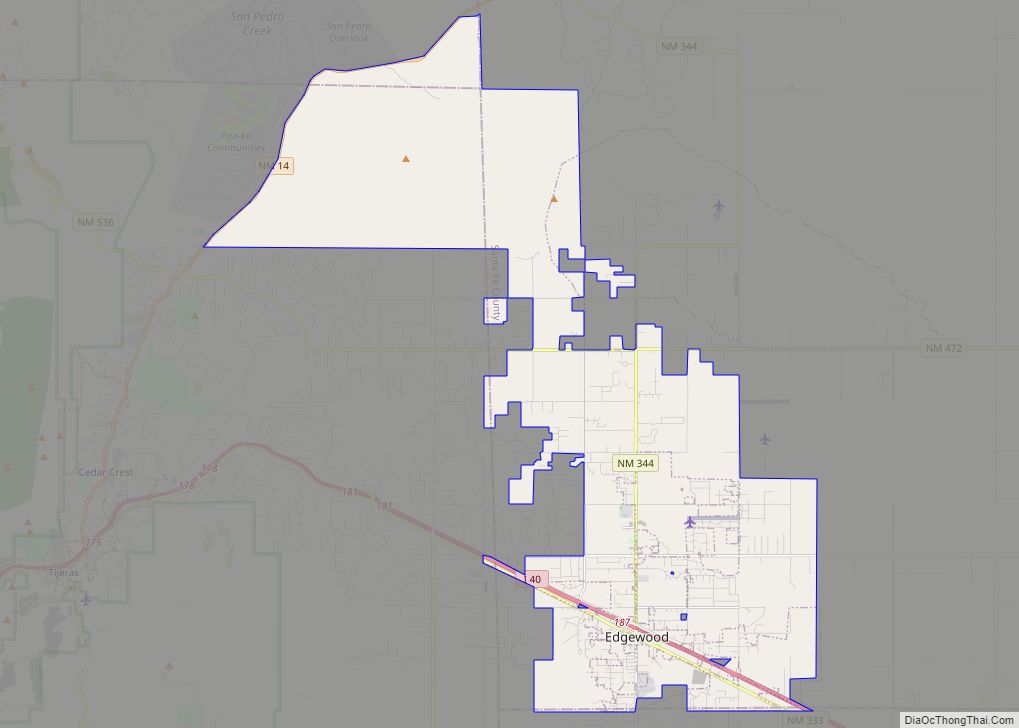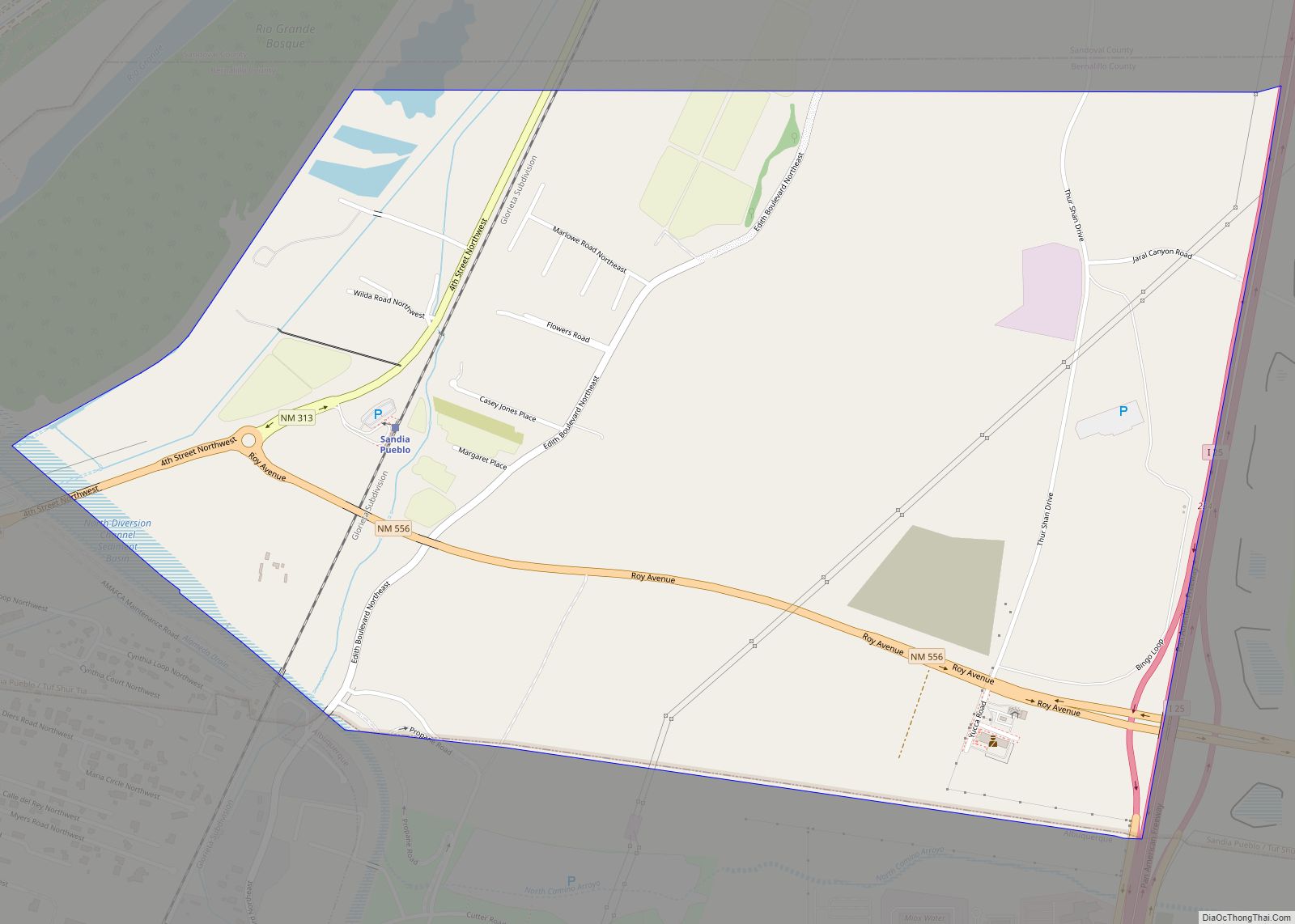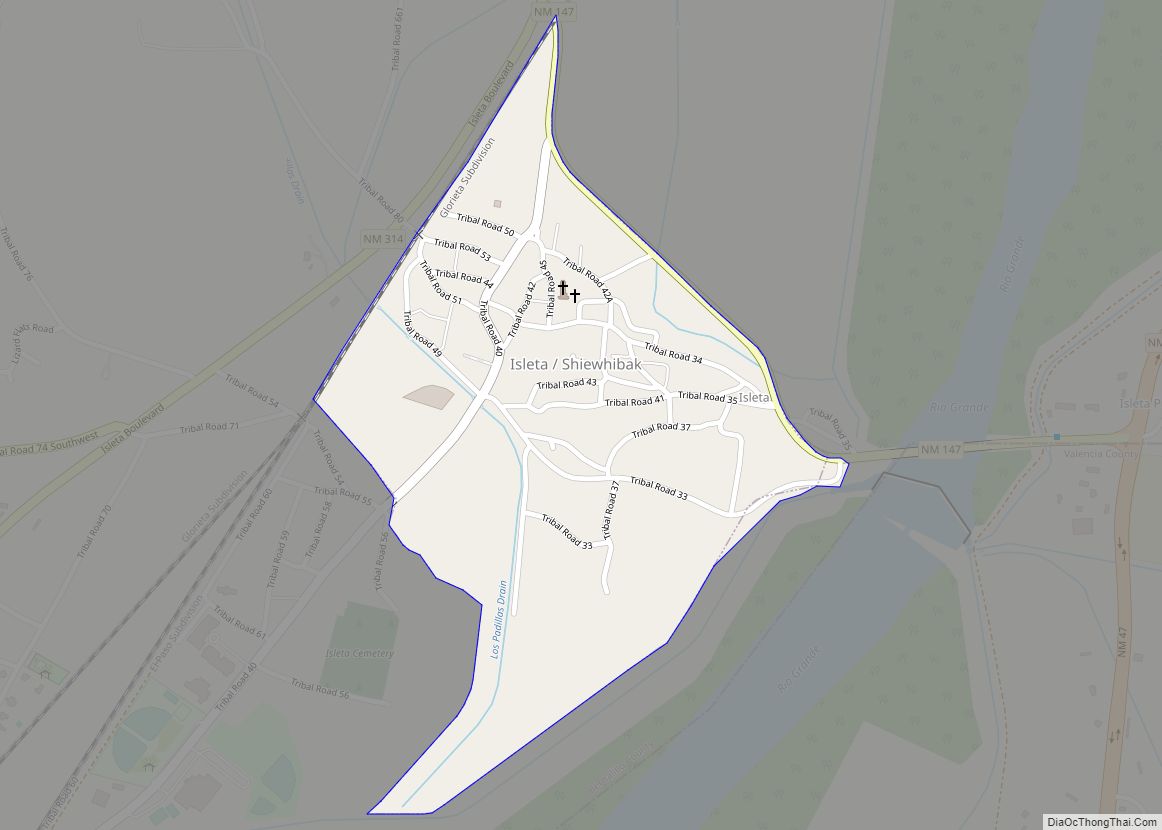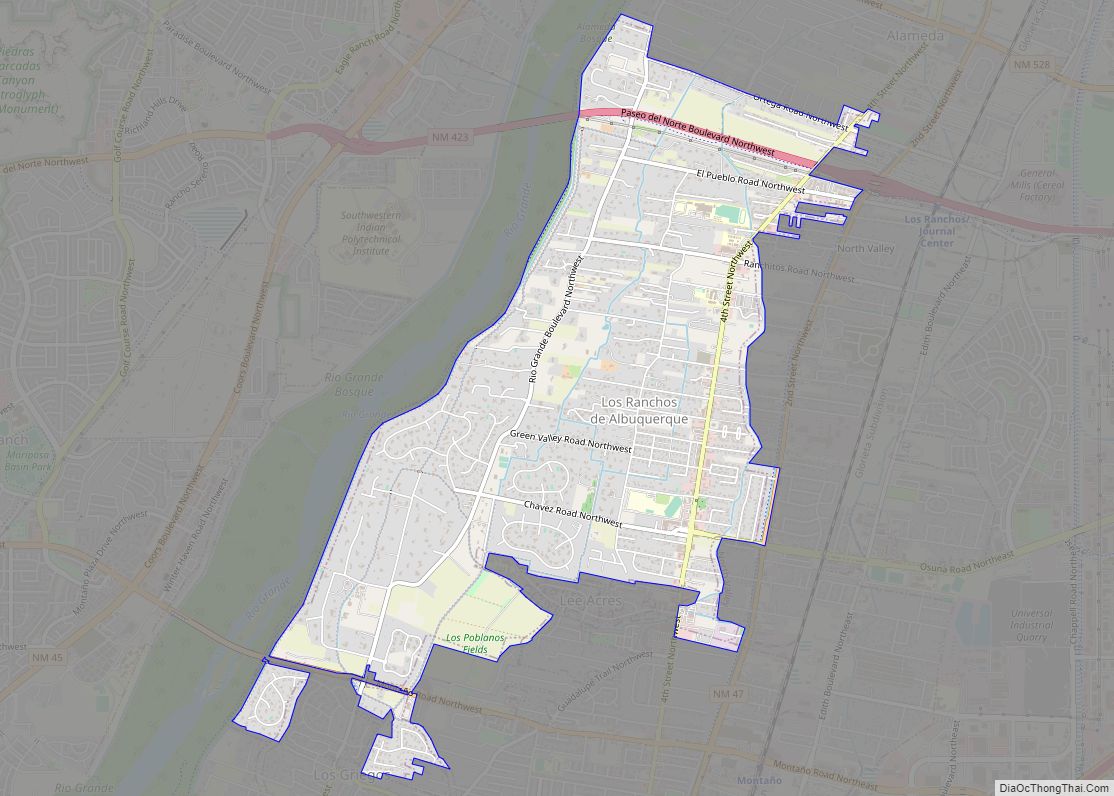Albuquerque (/ˈælbəˌkɜːrki/ (listen) AL-bə-kur-kee; Spanish: [alβuˈkeɾke]), abbreviated ABQ, is the most populous city in the U.S. state of New Mexico. Its nicknames, The Duke City and Burque, both reference its founding in 1706 as La Villa de Alburquerque by Nuevo México governor Francisco Cuervo y Valdés. Named in honor of the Viceroy of New Spain, the 10th Duke of Alburquerque, the city was an outpost on El Camino Real linking Mexico City to the northernmost territories of New Spain. In 2006 the city celebrated its 300th anniversary.
Located in the Albuquerque Basin, the city is flanked by the Sandia Mountains to the east and the West Mesa to the west, with the Rio Grande and bosque flowing north-to-south through the middle of the city. According to the 2020 census, Albuquerque had 564,559 residents, making it the 32nd-most populous city in the United States and the fourth largest in the Southwest. The Albuquerque metropolitan area had 916,528 residents in 2020, and forms part of the Albuquerque–Santa Fe–Las Vegas combined statistical area, which had a population of 1,162,523.
Albuquerque is a hub for technology and media companies, historic landmarks, and the fine arts. The city is home to the University of New Mexico, the Albuquerque International Balloon Fiesta, the Gathering of Nations, the New Mexico State Fair, and a diverse restaurant scene, which features both New Mexican and global cuisine.
| Name: | Albuquerque city |
|---|---|
| LSAD Code: | 25 |
| LSAD Description: | city (suffix) |
| State: | New Mexico |
| County: | Bernalillo County |
| Founded: | 1706 (as Alburquerque) |
| Incorporated: | 1891 (as Albuquerque) |
| Elevation: | 5,312 ft (1,619.1 m) |
| Land Area: | 187.27 sq mi (485.03 km²) |
| Water Area: | 1.68 sq mi (4.36 km²) |
| Population Density: | 3,014.68/sq mi (1,163.97/km²) |
| FIPS code: | 3502000 |
| GNISfeature ID: | 928679 |
| Website: | cabq.gov |
Discover the city of Albuquerque with our interactive map. It includes a road map, 10 things to do, and a list of attractions. Explore the city’s history, culture, and attractions to make the most of your trip. From the Albuquerque International Balloon Fiesta to the city’s amazing restaurants, you’ll find plenty of activities and attractions to keep you busy.
Whether you’re looking for an Albuquerque map or just want to explore the city, our interactive map is the perfect tool to make your trip a success. Discover the city’s history, culture, and attractions and make the most of your trip. From the Albuquerque International Balloon Fiesta to the city’s amazing restaurants, you’ll find plenty of activities and attractions to keep you busy.
Online Interactive Map
Click on ![]() to view map in "full screen" mode.
to view map in "full screen" mode.
Albuquerque has drawn visitors for decades because of its unique culture, population, and history. Today, more than 550,000 people live in the metropolitan area of Albuquerque. By using this interactive map, you can explore the many tourist attractions to see.
Albuquerque location map. Where is Albuquerque city?
History
Petroglyphs carved into basalt in the western part of the city bear testimony to an early Native American presence in the area, now preserved in the Petroglyph National Monument.
The Tanoan and Keresan peoples had lived along the Rio Grande for centuries before European settlers arrived in what is now Albuquerque. By the 1500s, there were around 20 Tiwa pueblos along a 60-mile (97 km) stretch of river from present-day Algodones to the Rio Puerco confluence south of Belen. Of these, 12 or 13 were densely clustered near present-day Bernalillo and the remainder were spread out to the south.
Two Tiwa pueblos lie specifically on the outskirts of the present-day city, both of which have been continuously inhabited for many centuries: Sandia Pueblo, which was founded in the 14th century, and the Pueblo of Isleta, for which written records go back to the early 17th century, when it was chosen as the site of the San Agustín de la Isleta Mission, a Catholic mission.
The Navajo, Apache, and Comanche peoples were also likely to have set camps in the Albuquerque area, as there is evidence of trade and cultural exchange among the different Native American groups going back centuries before European arrival.
Albuquerque was founded in 1706 as an outpost as La Villa de Alburquerque by Francisco Cuervo y Valdés in the provincial kingdom of Santa Fe de Nuevo México and named after the Viceroy Francisco Fernández de la Cueva, 10th duke of Alburquerque, which is from a town in Spain. Albuquerque was a farming and shepherding community and strategically located trading and military outpost along the Camino Real, for the other already established for the Tiquex and Hispano towns in the area, such as Barelas, Corrales, Isleta Pueblo, Los Ranchos, and Sandia Pueblo.
After 1821, Mexico also had a military presence there. The town of Alburquerque was built in the traditional Spanish villa pattern: a central plaza surrounded by government buildings, homes, and a church. This central plaza area has been preserved and is open to the public as a cultural area and center of commerce. It is referred to as “Old Town Albuquerque” or simply “Old Town”. Historically it was sometimes referred to as “La Placita” (Little Plaza in Spanish). On the north side of Old Town Plaza is San Felipe de Neri Church. Built in 1793, it is one of the oldest surviving buildings in the city.
After the New Mexico Territory became a part of the United States, Albuquerque had a federal garrison and quartermaster depot, the Post of Albuquerque, from 1846 to 1867. In Beyond the Mississippi (1867), Albert D. Richardson, traveling to California via coach, passed through Albuquerque in late October 1859—its population was 3,000 at the time—and described it as “one of the richest and pleasantest towns, with a Spanish cathedral and other buildings more than two hundred years old.”
During the Civil War, Albuquerque was occupied for a month in February 1862 by Confederate troops under General Henry Hopkins Sibley, who soon afterwards advanced with his main body into northern New Mexico. During his retreat from Union troops into Texas, he made a stand on April 8, 1862 at Albuquerque and fought the Battle of Albuquerque against a detachment of Union soldiers commanded by Colonel Edward R. S. Canby. This daylong engagement at long range led to few casualties, as the citizens of Albuquerque aided the Republican Union to rid the city of the occupying Confederate troops.
When the Atchison, Topeka and Santa Fe Railroad arrived in 1880, it bypassed the Plaza, locating the passenger depot and railyards about 2 miles (3 km) east in what quickly became known as New Albuquerque or New Town. The railway company built a hospital for its workers that was later a juvenile psychiatric facility and has now been converted to a hotel. Many Anglo merchants, mountain men, and settlers slowly filtered into Albuquerque, creating a major mercantile commercial center which is now Downtown Albuquerque. From this commercial center on July 4, 1882, Park Van Tassel became the first to fly a balloon in Albuquerque with a landing at Old Town. This was also the first flight in the New Mexico Territory. Due to a rising rate of violent crime, gunman Milt Yarberry was appointed the town’s first marshal that year. New Albuquerque was incorporated as a town in 1885, with Henry N. Jaffa its first mayor. It was incorporated as a city in 1891. Old Town remained a separate community until the 1920s when it was absorbed by Albuquerque. Old Albuquerque High School, the city’s first public high school, was established in 1879. Congregation Albert, a Reform synagogue established in 1897, is the oldest continuing Jewish organization in the city.
By 1900, Albuquerque boasted a population of 8,000 inhabitants and all the modern amenities, including an electric street railway connecting Old Town, New Town, and the recently established University of New Mexico campus on the East Mesa. In 1902, the famous Alvarado Hotel was built adjacent to the new passenger depot, and it remained a symbol of the city until it was razed in 1970 to make room for a parking lot. In 2002, the Alvarado Transportation Center was built on the site in a manner resembling the old landmark. The large metro station functions as the downtown headquarters for the city’s transit department. It also serves as an intermodal hub for local buses, Greyhound buses, Amtrak passenger trains, and the Rail Runner commuter rail line.
New Mexico’s dry climate brought many tuberculosis patients to the city in search of a cure during the early 20th century, and several sanitaria sprang up on the West Mesa to serve them. Presbyterian Hospital and St. Joseph Hospital, two of the largest hospitals in the Southwest, had their beginnings during this period. Influential New Deal–era governor Clyde Tingley and famed Southwestern architect John Gaw Meem were among those brought to New Mexico by tuberculosis.
The first travelers on Route 66 appeared in Albuquerque in 1926, and before long, dozens of motels, restaurants, and gift shops had sprung up along the roadside to serve them. Route 66 originally ran through the city on a north–south alignment along Fourth Street, but in 1937 it was realigned along Central Avenue, a more direct east–west route. The intersection of Fourth and Central downtown was the principal crossroads of the city for decades. The majority of the surviving structures from the Route 66 era are on Central, though there are also some on Fourth. Signs between Bernalillo and Los Lunas along the old route now have brown, historical highway markers denoting it as Pre-1937 Route 66.
The establishment of Kirtland Air Force Base in 1939, Sandia Base in the early 1940s, and Sandia National Laboratories in 1949, would make Albuquerque a key player of the Atomic Age. Meanwhile, the city continued to expand outward into the Northeast Heights, reaching a population of 201,189 by 1960. In 1990, it was 384,736 and in 2007 it was 518,271. In June 2007, Albuquerque was listed as the sixth fastest-growing city in the United States. In 1990, the U.S. Census Bureau reported Albuquerque’s population as 34.5% Hispanic and 58.3% non-Hispanic white.
On April 11, 1950, a USAF B-29 bomber carrying a nuclear weapon crashed into a mountain near Manzano Base. On May 22, 1957, a B-36 accidentally dropped a Mark 17 nuclear bomb 4.5 miles from the control tower while landing at Kirtland Air Force Base. Only the conventional trigger detonated, the bomb being unarmed. These incidents were classified for decades.
Albuquerque’s downtown entered the same phase and development (decline, “urban renewal” with continued decline, and gentrification) as nearly every city across the United States. As Albuquerque spread outward, the downtown area fell into a decline. Many historic buildings were razed in the 1960s and 1970s to make way for new plazas, high-rises, and parking lots as part of the city’s urban renewal phase. As of 2010, only recently has Downtown Albuquerque come to regain much of its urban character, mainly through the construction of many new loft apartment buildings and the renovation of historic structures such as the KiMo Theater, in the gentrification phase.
During the 21st century, Albuquerque’s population has continued to grow rapidly. The population of the city proper was estimated at 528,497 in 2009, up from 448,607 in the 2000 census. During 2005 and 2006, the city celebrated its tricentennial with a diverse program of cultural events.
The passage of the Planned Growth Strategy in 2002–2004 was the community’s strongest effort to create a framework for a more balanced and sustainable approach to urban growth.
Urban sprawl is limited on three sides—by the Sandia Pueblo to the north, the Isleta Pueblo and Kirtland Air Force Base to the south, and the Sandia Mountains to the east. Suburban growth continues at a strong pace to the west, beyond the Petroglyph National Monument, once thought to be a natural boundary to sprawl development.
Because of less-costly land and lower taxes, much of the growth in the metropolitan area is taking place outside of the city of Albuquerque itself. In Rio Rancho to the northwest, the communities east of the mountains, and the incorporated parts of Valencia County, population growth rates approach twice that of Albuquerque. The primary cities in Valencia County are Los Lunas and Belen, both of which are home to growing industrial complexes and new residential subdivisions. The mountain towns of Tijeras, Edgewood, and Moriarty, while close enough to Albuquerque to be considered suburbs, have experienced much less growth compared to Rio Rancho, Bernalillo, Los Lunas, and Belen. Limited water supply and rugged terrain are the main limiting factors for development in these towns. The Mid Region Council of Governments (MRCOG), which includes constituents from throughout the Albuquerque area, was formed to ensure that these governments along the middle Rio Grande would be able to meet the needs of their rapidly rising populations. MRCOG’s cornerstone project is currently the New Mexico Rail Runner Express. In October 2013, the Albuquerque Journal reported Albuquerque as the third best city to own an investment property.
Albuquerque Road Map
Albuquerque is situated in an arid high desert area on the Rio Grande close to the foothills of the Sandia Mountains and immediately south of the Jemez Mountains. If you’re in need of a road map for Albuquerque, New Mexico, then look no further. This Albuquerque road map is not only functional and convenient to use, but it also includes helpful information on highways and road names.
Interstate Highways: 25, 40
State Highways: 45, 47, 303, 313, 314, 345, 448, 423, 500, 528, 556
Major Roads: Alameda Blvd, Candelaria Rd, Central Ave, Comanche Rd, Del Norte, Indian School Rd, Lomas Blvd, Menaul Blvd, Montgomery Blvd, Pan American East Fwy, Pan American Fwy, Pan American West Fwy, Spain Rd, Tramway Blvd
Roads: Academy Rd, Candelaria Rd, Cesar Chavez, Coors Blvd, Del Norte, Eubank Blvd, Frontage Rd, Gibson Blvd, Juan Tabo Blvd, Locust St, Lomas Blvd, Menaul Blvd, Montano Rd, Montgomery Blvd, Mountain Rd, Oak St, Osuna Rd, Pan American Fwy, Rio Bravo Blvd, San Mateo Blvd, Stadium Blvd, Sunport Blvd, Taylor Ranch Rd, University Blvd, Unser Blvd, Wyoming Blvd, Yale Blvd
If you’re looking for highways and interstates of the entire state, then you can use our New Mexico road map.
Whether you’re visiting Albuquerque for a weekend getaway or staying for longer, there are plenty of places to explore! Our map will help you find what’s best for your needs and some fun parks and places to visit. From downtown Albuquerque to Corrales, Los Ranchos de Albuquerque, Carnuel, Edith Endave, Isleta Village Proper, North Valley, Pajarito Mesa, Paradise Hills, Pueblo of Sandia Village, Sandia Heights, South Valley, and Rio Rancho, there’s something new around every corner. You don’t have to be a native to enjoy all this city has to offer. If you’re looking for natural features, you can also find our New Mexico lakes and rivers map at a state level.
10 things to do in Albuquerque city
Exploring Albuquerque is a great way to experience the city’s diverse landscape. With a map for travel, visitors can easily find the best places to go and the amenities they need. From Old Town to Downtown Plaza, Nob Hill to Balloon Fiesta Park and beyond, there’s always something new to explore in Albuquerque.
Some of the must-see attractions in the city include the Sandia Peak Tramway, Petroglyph National Monument, National Museum of Nuclear Science & History, ABQ BioPark – Zoo, Old Town, Indian Pueblo Cultural Center, New Mexico Museum of Natural History and Science, Cibola National Forest & National Grasslands, Anderson Abruzzo Albuquerque International Balloon Museum, and Tingley Beach.
Take a journey through Albuquerque and explore the many wonders it has to offer. With a map for travel, you can easily navigate the diverse landscape and find the best places to go and the amenities you need. From Old Town to Downtown Plaza, Nob Hill to Balloon Fiesta Park and more, there’s always something new to discover in Albuquerque.
Albuquerque city Satellite Map
See also
Map of New Mexico State and its subdivision: Map of other states:- Alabama
- Alaska
- Arizona
- Arkansas
- California
- Colorado
- Connecticut
- Delaware
- District of Columbia
- Florida
- Georgia
- Hawaii
- Idaho
- Illinois
- Indiana
- Iowa
- Kansas
- Kentucky
- Louisiana
- Maine
- Maryland
- Massachusetts
- Michigan
- Minnesota
- Mississippi
- Missouri
- Montana
- Nebraska
- Nevada
- New Hampshire
- New Jersey
- New Mexico
- New York
- North Carolina
- North Dakota
- Ohio
- Oklahoma
- Oregon
- Pennsylvania
- Rhode Island
- South Carolina
- South Dakota
- Tennessee
- Texas
- Utah
- Vermont
- Virginia
- Washington
- West Virginia
- Wisconsin
- Wyoming
